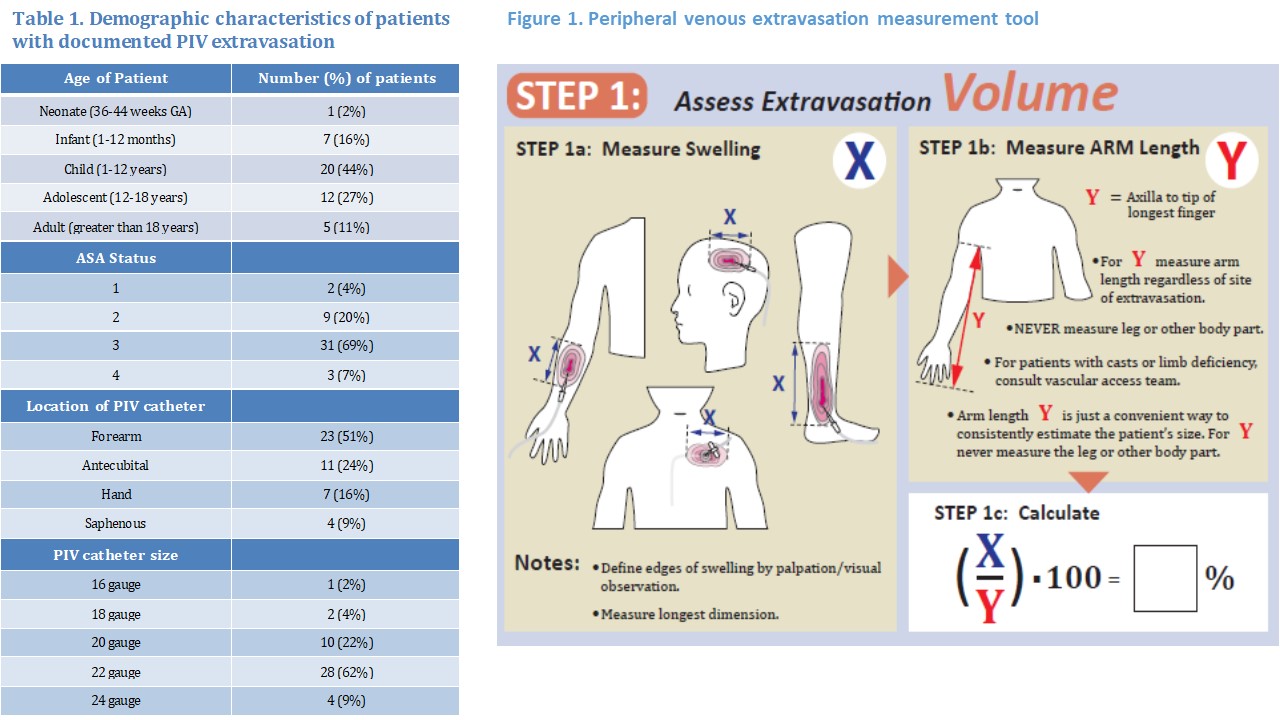NM-333
Peripheral intravenous extravasation in perioperative pediatric patients: A retrospective review
McSoley J, Mecoli M, Subramanyam R, Doellman D, Rineair S
Cincinnati Childrens Medical Center, Cincinnati, OH, USA
Introduction:
Extravasation is the unintended leakage of intravenous fluid or medication into the extravascular tissue surrounding the site of infusion and may or may not be associated with significant tissue injury (1). The incidence of peripheral intravenous extravasation (PIVE) among hospitalized pediatric patients has been reported between 0.1% and 6.5%, however there is paucity of data regarding the incidence of PIVE in the operating room. This retrospective study aimed to determine the incidence of PIVE in the perioperative setting and describe the characteristics of these extravasations in pediatric surgical patients.
Methods:
Following IRB approval, data (age, ASA status, catheter size and location, number of attempts at cannulation, presence of ultrasound use for cannulation, and size of extravasation) from EMR of all documented PIVEs in the operating room at our institution from 1/1/2015 through 1/1/2017 were collected. Additionally, the total number of peripheral venous catheters in place during all anesthetics performed in the operating room during the same time period was recorded. PIVE was defined by swelling of the effected limb greater than 30% using our institution’s extravasation assessment tool (Figure 1). PIVEs with swelling from 30% to 59% were graded as moderate and 60% to 100% were graded as severe. Evidence of severe harm defined as absence of distal pulses, limb ischemia, or injury requiring fasciotomy was recorded.
Results:
During this 24 month time period 60,678 PIV catheters were documented as being in place in the OR. A total of 45 patients were identified as having a PIVE for an overall incidence of 0.07%. Demographic information is shown in Table 1. Ultrasound was utilized in 46% (n=21) of extravasated catheters and 35% (n=16) of catheters required more than one attempt at cannulation. Of the 45 catheters with extravasation, 42% (n=19) were in place preoperatively and 58% (n=26) were placed in the OR. Of the extravasations, 76% (n=34) were graded moderate and 24% (n=11) were severe. There were no occurrences of severe harm noted in the extravasations identified.
Discussion:
To our knowledge, this is the first study that attempts to define the incidence of significant PIVE in the OR in a pediatric population. PIVE in the OR was found to be rare and no severe harm was noted in our review. While this study describes the characteristics of PIVE in this population, relative risk factors were not identified. Additional research is warranted to determine what factors may be predictive of PIVE in pediatric surgical patients. Careful and regular assessment of peripheral venous catheters may be challenging in pediatric surgical patients due to limited access to PIV sites and a desire to avoid disrupting surgical care. Further information may help inform perioperative recommendations for monitoring PIV sites in the operating room.
References:
Paquette V, et al. Can J Hosp Pharm 2001;64(5):340-345
Top












